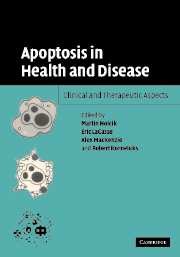Book contents
- Frontmatter
- Contents
- List of contributors
- Preface
- 1 Apoptosis in health, disease, and therapy: overview and methodology
- 2 Developmental apoptosis in health and disease
- 3 Apoptosis and cancer
- 4 Neuronal cell death in human neurodegenerative diseases and their animal/cell models
- 5 Apoptosis in the cardiovascular system: incidence, regulation, and therapeutic options
- 6 Cytotoxic lymphocytes, apoptosis, and autoimmunity
- 7 Pro- and anti-apoptotic strategies of viruses
- Index
- Plate section
- References
4 - Neuronal cell death in human neurodegenerative diseases and their animal/cell models
Published online by Cambridge University Press: 03 March 2010
- Frontmatter
- Contents
- List of contributors
- Preface
- 1 Apoptosis in health, disease, and therapy: overview and methodology
- 2 Developmental apoptosis in health and disease
- 3 Apoptosis and cancer
- 4 Neuronal cell death in human neurodegenerative diseases and their animal/cell models
- 5 Apoptosis in the cardiovascular system: incidence, regulation, and therapeutic options
- 6 Cytotoxic lymphocytes, apoptosis, and autoimmunity
- 7 Pro- and anti-apoptotic strategies of viruses
- Index
- Plate section
- References
Summary
Introduction
Cell death is important in the normal histogenesis of organs, steady state kinetics of healthy adult tissues, pathogenesis of tissue damage and disease, and disease therapy. Pathologists conceived the concept of cell death as a mechanism for disease to aid in diagnosis and therapy (Virchow, 1858). Developmental biologists then realized the essential role of cell death in tissue and organ development (Glücksmann, 1951; Lockshin and Williams, 1964; Saunders, 1966). This idea was at first received with skepticism, but now it is dogma that cell number in tissues is controlled precisely in developing and adult tissues. The absence of this precise control of cell number in tissues causes cancer (impaired apoptosis is a central step toward neoplasia). Pathologic stimuli can be extrinsic or intrinsic and can inactivate normal cell death networks or can cause abrupt or delayed cell death. Cell demise can occur as multiple types of death (Schweichel and Merker, 1973; Lockshin and Zakeri, 2002). It is compelling that a goal of human disease therapy is, on the one hand, to prevent cell death in neurologic disease and, on the other hand, to stimulate cell death in malignancy. Thus, the study of cell death is fundamental to human pathobiology and disease treatment. In this chapter, recent critical views on the contributions of the different forms of cell death to human neurodegenerative diseases and their animal and cell models will be presented.
- Type
- Chapter
- Information
- Apoptosis in Health and DiseaseClinical and Therapeutic Aspects, pp. 96 - 155Publisher: Cambridge University PressPrint publication year: 2005
References
- 1
- Cited by



